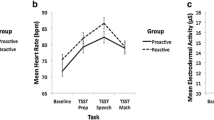Abstract
The study investigated how coping style differences affected performance on the cold pressor task. Reactions of “monitors” (individuals who prefer having information about stressors) and “blunters” (individuals who avoid cues connected with stressors) were compared, using different instructional sets. The study also assessed the effectiveness of paradoxical intention compared to more traditional cognitive strategies. Monitors and blunters were identified using Miller's recently developed Behavioral Style Scale. All instructional sets improved performance in comparison to a control condition, and individuals generally did better when an instructional set supported their preferred coping style. Paradoxical intention did not show any decided advantage over other strategies. The desirability of designing stress management programs to fit individual coping style patterns is discussed.
Similar content being viewed by others
References
Ahles, T. A., and Blanchard, E. B. (1983). Cognitive control of pain: Attention to the sensory aspects of the cold pressor stimulus.Cognit. Ther. Res. 7: 159–178.
Ascher, L. M. (1980). Paradoxical intention. In Goldstein, A., and Foa, E. B. (eds.),Handbook of Behavioral Interventions, John Wiley, New York.
Ascher, L. M., and DiTomasso, R. A. (1985). Paradoxical intention in behavior therapy: A review of the experimental literature. In Turner, R. M., and Ascher, L. M. (eds.),Evaluating Behavior Therapy, Springer, New York.
Ascher, L. M., and Efran, J. S. (1978). The use of paradoxical intention in a behavioral program for sleep onset insomnia.J. Consult. Clin. Psychol. 46: 547–550.
Avia, M. D., and Kanfer, F. H. (1980). Coping with aversive stimulation: The effects of training in a self-management context.Cognit. Ther. Res. 4: 73–81.
Beers, T. M., and Karoly, P. (1979). Cognitive strategies, expectancy, and coping style in the control of pain.J. Consult. Clin. Psychol. 47: 179–180.
Byrne, D. (1961). The repression-sensitization scale: Rationale, reliability, and validity.J. Personal. 29: 334–349.
Byrne, D. (1964). Repression-sensitization as a dimension of personality. In Maher, B. A. (ed.),Progress in Experimental Personality Research, Vol. 1. Academic Press, New York.
Crowne, D. P., and Marlowe, D. A. (1964).The Approval Motive, Wiley, New York.
Epstein, S., and Fenz, W. D. (1967). The detection of areas of emotional stress through variations in perceptual threshold and physiological arousal.J. Exp. Res. Personal. 2: 191–199.
Gard, D., Edwards, P. W., Harris, J., and McCormack, G. (1988). Sensitizing effects of pretreatment measures on cancer chemotherapy nausea and vomiting.J. Consult. Clin. Psychol. 56: 80–84.
Gilligan, R. M., Ascher, L. M., Wolper, J., and Bochachevsky, C. (1984). Comparison of three cognitive stratgegies in altering pain behaviors on a cold pressor task.Percept. Motor Skills, 59: 235–240.
Greenstein, S. M. (1984). Pleasant and unpleasant slides: Their effects on pain tolerance.Cognit. Ther. Res. 8: 201–210.
Horwitz, E. A., Shipley, R. H., and McGuire, D. (1977). The use of external distractors to reduce pain and anxiety associated with stressful medical and dental procedures. Paper presented at the meeting of the Association for the Advancement of Behavior Therapy, Atlanta.
Kirk, R. E. (1968).Experimental Design: Procedures for the Behavioral Sciences, Brooks/Cole, Belmont, Calif.
McCaul, K. D., and Haugtvedt, C. (1982). Attention, distraction, and cold-pressor pain.J. Personal. Soc. Psychol. 43: 154–162.
McCaul, K. D., and Malott, J. M. (1984). Distraction and coping with pain.Psychol. Bull. 95: 516–533.
Melzack, R. (1973).The Puzzle of Pain, Basic Books, New York.
Miller, S. M. (1979). Coping with impending stress: A behavioral, subjective, and psychophysiological analysis.Psychophysiology 16: 572–581.
Miller, S. M. (1980). When is a little information a dangerous thing? Coping with stressful life-events by monitoring vs. blunting. In Levine, S., and Ursin, H. (eds.),Coping and Health, Plenum Press, New York.
Miller, S. M. (1987). Monitoring and blunting: Validation of a questionnaire to assess styles of information-seeking under threat.J. Personal. Soc. Psychol. 52: 345–353.
Miller, S. M., and Mangan, C. E. (1983). Interacting effects of information and coping style in adapting to gynecologic stress: Should the doctor tell all?J. Personal. Soc. Psychol. 45: 223–236.
Miller, S. M., Brody, D. S., and Summerton, J. (1988). Styles of coping with threat: Implications for health.J. Personal. Soc. Psychol. 54: 142–148.
Miller, S. M., Leinbach, A., and Brody, D. S. (1989). Coping style in hypertensives: Nature and consequences for treatment.J. Consult. Clin. Psychol. 57(3): 339–343.
Pennebaker, J. W., and Lightner, J. M. (1980). Competition of internal and external information in an exercise setting.J. Personal. Soc. Psychol. 39: 165–174.
Phipps, S., and Zinn, A. B. (1986). Psychological response to amniocentesis. II. Effects of coping style.Am. J. Med. Genet. 25: 143–148.
Rosenbaum, M. (1980). Individual differences in self-control behaviors and tolerance of painful stimulation.J. Abnorm. Psychol. 89: 581–590.
Spanos, N. P., Radtke-Bodorik, L., Ferguson, J. D., and Jones, B. (1979). The effects of hypnotic susceptibility, suggestions for analgesia, and the utilization of cognitive strategies on the reduction of pain.J. Abnorm. Psychol. 88: 282–292.
Steptoe, A., and O'Sullivan, J. (1986). Monitoring and blunting coping styles in women prior to surgery.Br. J. Clin. Psychol. 25: 143–144.
Stevenson, M. K., Kanfer, F. H., and Higgins, J. M. (1984). Effects of goal specificity and time cues on pain tolerance.Cognit. Ther. Res. 8: 415–426.
Taylor, L. W., Odegaard, V., and Watkins, L. O. (1983). Benefits of sensory instruction in preparation for cardiac catheterization: A randomized, controlled trial.Circulation 68: III-191.
Tellegen, A., and Atkinson, G. (1974). Openness to absorbing and self-altering experiences (“absorption”): A trait related to hypnotic susceptibility.J. Abnorm. Psychol. 83: 268–277.
Watkins, L. O., Weaver, L., and Odegaard, V. (1986). Preparation for cardiac catheterization: Tailoring the content of instruction to coping style.Heart Lung 15: 382–389.
Author information
Authors and Affiliations
Rights and permissions
About this article
Cite this article
Efran, J.S., Chorney, R.L., Ascher, L.M. et al. Coping styles, paradox, and the cold pressor task. J Behav Med 12, 91–103 (1989). https://doi.org/10.1007/BF00844751
Accepted:
Issue Date:
DOI: https://doi.org/10.1007/BF00844751




